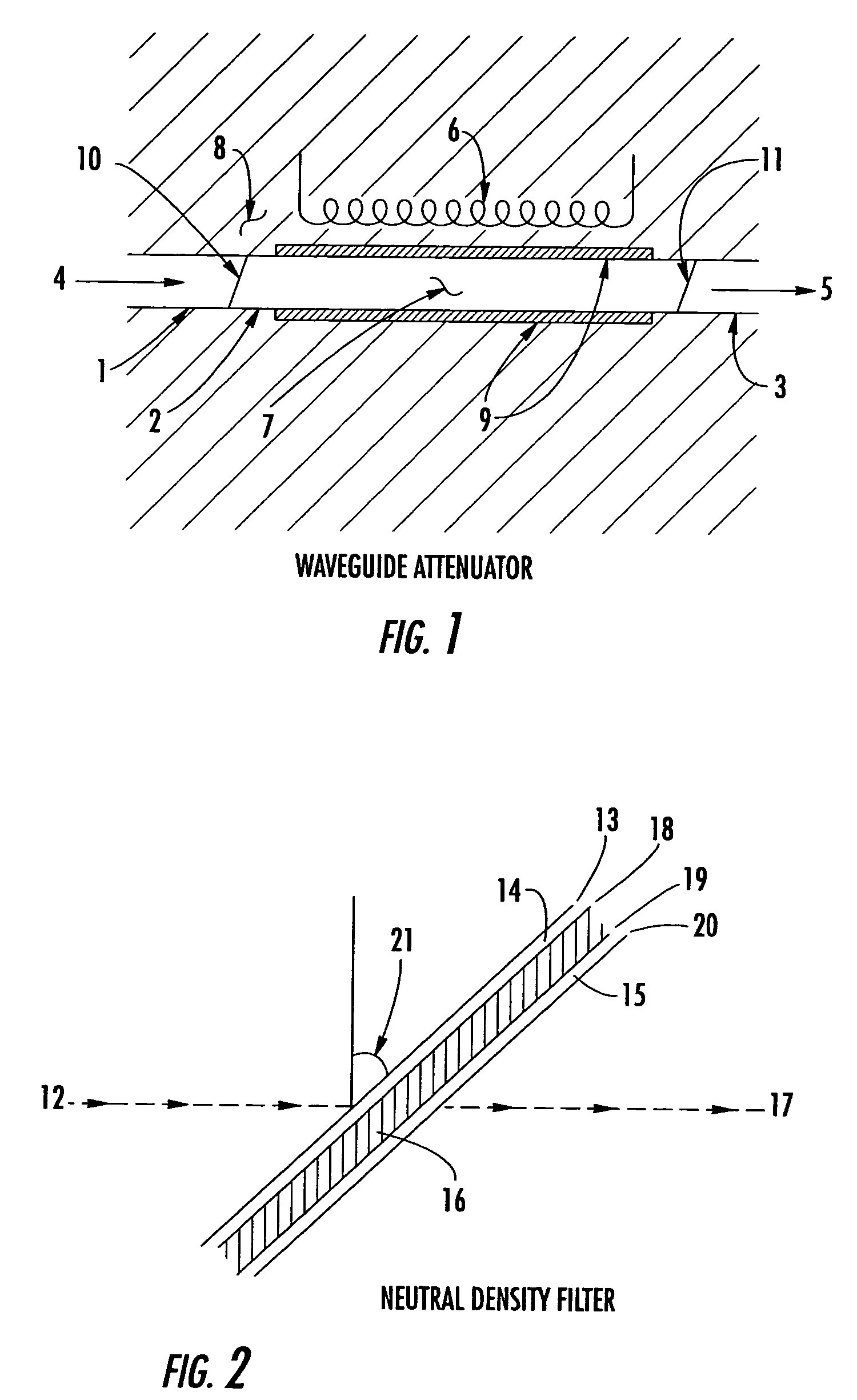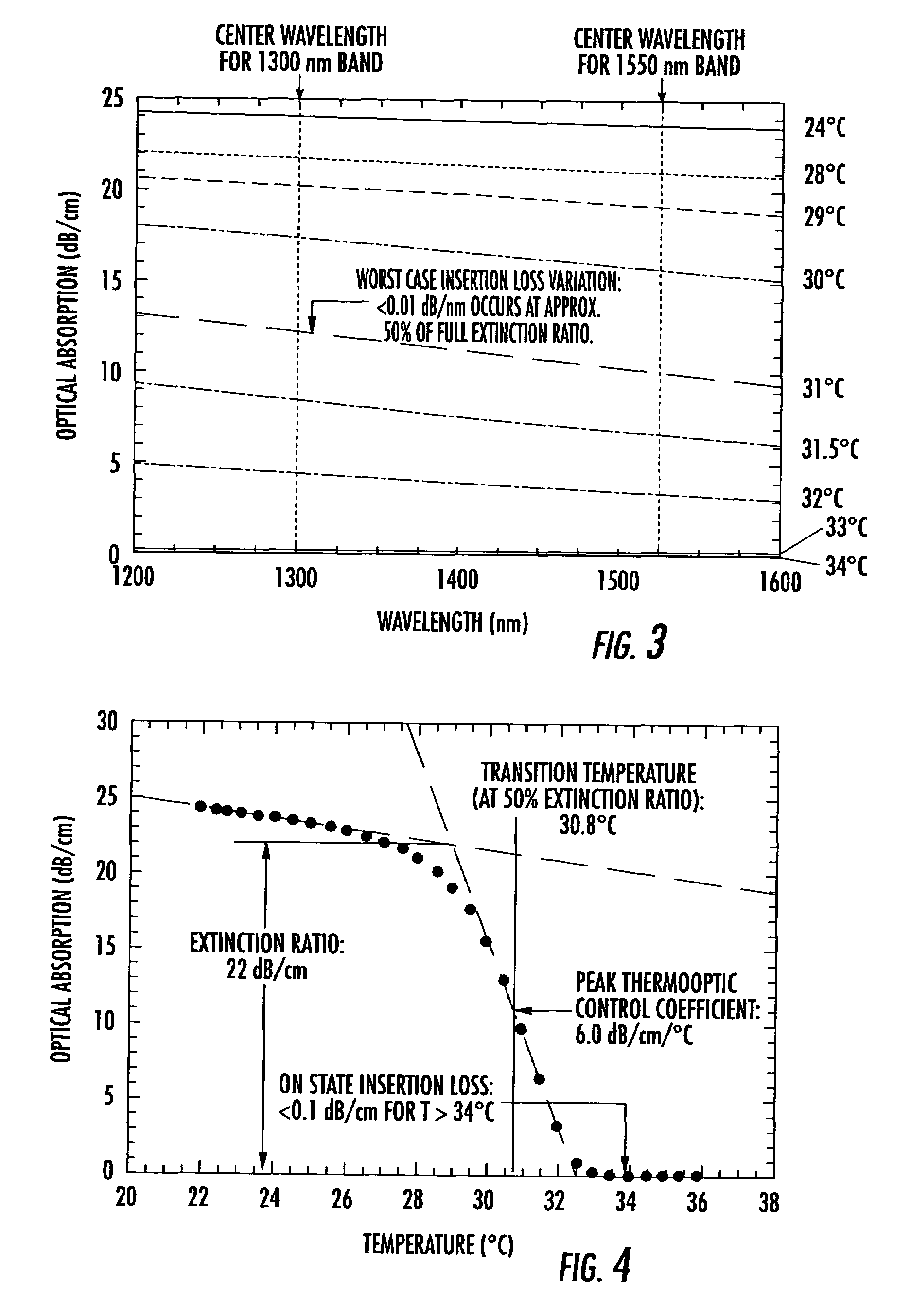[0007]A further
advantage of the present invention is that it exhibits a high thermooptic control coefficient. That is, for a modest change in the control parameter (temperature), a large change in
signal attenuation is realized. The measured thermooptic control coefficient for compositions of the present invention is in the range of 6 dB / cm / ° C. When combined with the low
insertion loss of the present invention of less than 0.1 dB / cm, this
figure of merit implies that for a relatively small change in temperature along a
waveguide, a relatively large change in attenuation can be achieved. For example, a ten-
centimeter long
waveguide attenuator using a composition of the present invention would exhibit an
insertion loss of 1 dB and 60 dB / ° C. thermooptic coefficient. So, with a control temperature change of only 0.2° C., such a device could switch 10 dB in attenuation. Allowing such a small change in temperature is a significant
advantage over the prior art because it permits, for a given thermooptic heating /
cooling power per unit length, a more rapid switching speed in any device utilizing compositions of the invention.
[0008]Yet another
advantage of the present invention is that it enables design of components that have attenuation that is smoothly varying and varies only gradually across its wavelengths of operation. Some thermooptically controlled devices must be optimized for performance in narrow bands of spectrum because their attenuation performance relies on
resonance or nulling phenomena. For example, devices which rely on the thermooptic change of
refractive index of a
polymer waveguide arm of a Mach-Zehnder interferometer must be optimized for a center
wavelength. Variation of operating wavelength by more than one quarter of the center wavelength value renders the device unable to achieve its ideal
phase cancellation point. In the prior art disclosed in U.S. Pat. No. 6,165,389, a switching medium is described which depends on a volume
phase transition phenomenon in the thermooptically active material; a preferred embodiment exhibits variation in optical absorption which is strongly resonant in wavelength. By contrast to the foregoing prior art examples, the present invention relies on bulk absorption due to a “
cloud point”
phase transition phenomenon; in addition, its absorption characteristics vary only slowly across the entire
wavelength band from 300 nm to 2000 nm without any rapidly varying
resonance attenuation features. Using compositions of the present invention, devices can be configured which exhibit only small changes in optical absorption across wavelength, which we denote “
insertion loss flatness”. A preferred embodiment of the invention, for example, achieves a worst case
insertion loss flatness of less than 0.01 dB / nm in the vicinity of NIR telecommunication bands over the
wavelength range of 1200 nm to 1600 nm.
[0009]A further characteristic of some optical polymer media such as
liquid crystal polymer media is that they exhibit
birefringence, meaning that their index of
refraction is significantly different for the two orthogonal
signal polarizations. This in turn leads to a deleterious feature known as
polarization dependent loss (PDL). In some applications such as polarization independent waveguide switches, or
free space neutral density filters, it would be desirable to realize behavior for a switch medium that is non-birefringent in nature and exhibits minimal PDL. The
cloud point mechanism which gives the present invention its switching characteristics is intrinsically non-birefringent in nature and may therefore be advantageous in such applications.
[0010]The composition of the present invention may be used to fill an optical waveguide structure. Such structures are commonly designed to ensure propagation in a single
waveguide mode. There are structures used in the
telecommunications field, which are also based on propagation of
multiple modes, known as
multimode waveguides. The compositions of the present invention may be used to fill both single mode and multimode waveguide devices. The prior art of optical waveguides as described in U.S. Pat. No. 5,692,088, also includes optical waveguides comprising a
liquid core. Compositions of the present invention may exist in a liquid, a quasi-liquid or a
solid state over a portion of their
operating temperature service range. The distinctive feature of the compositions of the present invention is that they exhibit a transition in optical absorption, which may be controlled through variation in temperature. Devices that will benefit from the incorporation of the invented composition into waveguide structures include waveguide switches, programmable waveguide attenuators, and controllable waveguide shutters.
[0011]In some applications for the present invention, the electromagnetic wave propagates in an unguided free-space mode rather than in a guided
waveguide mode.
Projection display optics, high power
laser optics, and other optical systems sometimes require neutral density filters, or controllable attenuators, or shutters which control the free-space amplitude of an optical
wavefront. In the prior art, reflective / absorptive free-space elements have been fabricated using transparent
liquid crystal arrays, or using microelectromechanical switch (MEMS) elements, or using electrically controlled
crystal elements such as Pockels cells. In one embodiment of the present invention, a free-space attenuating screen is formed by filling the gap between two closely spaced transparent sheets of glass with the invented composition. The temperature of the composition is varied to permit switching of the state of the filter through a range of neutral density values. This approach may be carried further to allow, across the two-dimensional face of the filter, independent control of localized attenuation. In this way, the present invention could be used to realize controllable beam shavers, image pixel amplitude equalizers, holographic image attenuation controllers, and the like.
[0012]The prior art also contains many compositions in the art of manufacture of greases, gels, plastics, paints, and other compounds wherein the mechanical properties of the compositions are altered by the addition of
powder thickening agents such as nanopowder silica, oxides, soaps, clays, or other materials. In some embodiments of the present invention, it may be advantageous to increase the
viscosity or stiffness of the invented compositions by means of addition of these components. It is preferred in these cases to select thickening agents that do not unduly increase the level of
haze in the composition. This may be accomplished, as is well known in the art of transmissive optical polymer compositions, by minimizing the effective particle size of the
thickening agent, minimizing the
volume fraction of the agent within the composition, and selecting agents with maximal optical
clarity and with index of
refraction close to that of the base composition. In like manner, fluid thickening agents such as tackifiers, or other high
viscosity fluids which are miscible with the base composition and which are well known in the art of
lubricant formulation may be compounded into the base composition in order to increase its
viscosity and reduce its tendency to migrate or flow once it is dispensed into the optical
assembly.
 Login to View More
Login to View More 


